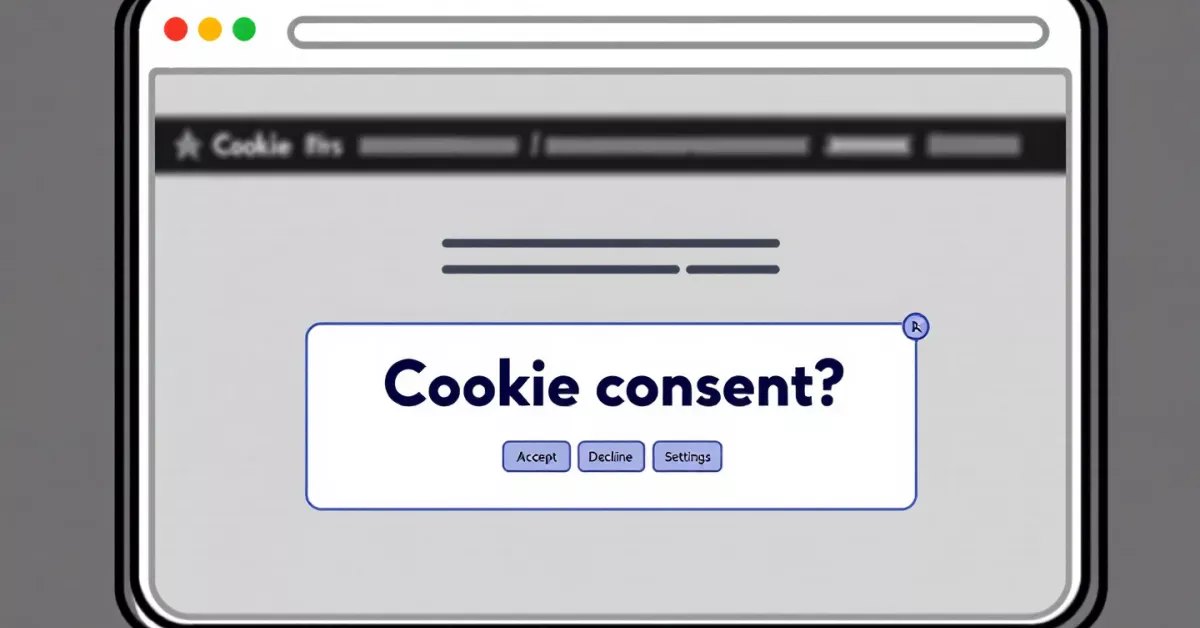You’ve seen them everywhere: those little banners popping up at the bottom of websites, asking about cookies. Sometimes they’re simple; other times, they offer a bewildering array of toggles and options. If you run a website targeting Australian users, you might be wondering: what exactly are my obligations? Getting cookie consent in Australia right isn’t just about ticking a legal box; it’s about respecting user privacy and building trust.

But let’s be honest, the rules can seem murky. Unlike Europe’s GDPR, Australia doesn’t have a separate law just for cookies. Instead, cookie requirements fall under the broader Privacy Act 1988 and its Australian Privacy Principles (APPs).
This overview will cut through the confusion. We’ll break down what cookies are, how Australian privacy law applies, and what practical steps you need to take to create a compliant and user-friendly experience on your website. We’ll keep it straightforward, using plain English and focusing on what matters for your site.
What Exactly Are Cookies (And Why Should You Care)?
Before diving into the legal side, let’s quickly recap what website cookies are. Think of them as small text files that a website stores on your device (computer, phone, tablet) when you visit. They act like little memory aids for the website.
Websites use cookies for various reasons:
- Making things work: Some cookies are essential for basic functions, like keeping you logged in or remembering items in your shopping cart (strictly necessary cookies).
- Understanding visitors: Others help website owners understand how people use their site – which pages are popular, how long people stay, etc. (analytics or performance cookies). This often involves collecting anonymous or aggregated data.
- Personalising experiences: Some cookies remember your preferences (like language settings) or help show you more relevant content (functionality cookies).
- Advertising: Many cookies are used to track your browsing habits across different sites to show you targeted ads (advertising or targeting cookies). These are often third-party cookies, set by domains other than the one you’re visiting.
While many cookies are harmless and improve user experience, others, particularly those used for tracking and advertising, raise privacy concerns. That’s because the information they collect can sometimes be linked back to an individual, which brings us to Australian privacy law.
The Main Law: Australia’s Privacy Act 1988

The cornerstone of data protection down under is the Privacy Act 1988. This Act governs how organisations (including most businesses with an annual turnover above $3 million, plus some others like health service providers) handle personal information.
Now, you might think: “Are cookies ‘personal information’?” The Act defines personal information as information or an opinion about an identified individual, or an individual who is reasonably identifiable.
Here’s the key bit: While a single cookie ID might seem anonymous, if the data collected through cookies (like browsing history, IP address, device details) can be combined with other information to reasonably identify a person, then it is considered personal information under the Act. The Office of the Australian Information Commissioner (OAIC), the body that enforces the Privacy Act, has confirmed this view, stating that the concept of collecting personal information is broad and includes data gathered via cookies.
Because cookies can collect personal information, their use is subject to the Australian Privacy Principles (APPs) set out in the Privacy Act. Two APPs are particularly relevant here: APP 5 (Notification) and the principles around consent.
Notifying Your Visitors: APP 5 Explained
APP 5 – Notification of the collection of personal information is crucial. It states that when an organisation collects personal information about an individual, it must take reasonable steps to notify the individual about certain matters at or before the time of collection, or if that’s not feasible, as soon as possible afterwards.
Think of your cookie banner as this notification. According to APP 5, your notification (banner and linked policies) should generally tell users:
- Who you are: Your organisation’s identity and contact details.
- Why you’re collecting: The purposes for using cookies (e.g., site function, analytics, advertising).
- Consequences (if any): What happens if they don’t consent to certain cookies (e.g., reduced site functionality).
- Who you share it with: The types of organisations you might disclose the information to (e.g., advertising partners, analytics providers).
- Overseas disclosure: If you’re likely to send personal information overseas, and if practical, which countries.
- Your Privacy Policy: How they can access your privacy policy, which should explain how they can access or correct their information and how they can complain about a breach of the APPs.
This sounds like a lot for a small banner! That’s why a layered approach is often best: the banner provides key information upfront and links to your detailed Privacy Policy and/or Cookie Policy for the full picture.
Getting Consent: The Tricky Part
This is where things often get confusing in Australia. The Privacy Act allows for two types of consent:
- Express Consent: This is a clear, direct indication of agreement, like ticking an “I agree” box for specific cookie types. Express consent is required for collecting sensitive information (like health data), but cookies generally don’t collect this.
- Implied Consent: This is consent that can be reasonably inferred from an individual’s actions or inaction. For cookies, some argue that continued browsing after seeing a clear notice could constitute implied consent for non-essential cookies.
However, relying on implied consent for cookies in Australia is risky and becoming less acceptable globally. For implied consent to be valid under the APPs, several conditions generally need to be met:
- The user must be adequately informed (clear notice).
- Consent must be voluntary (not forced).
- It must be current and specific (related to the particular use of cookies).
- The user must have the capacity to consent.
- Crucially for implied consent via opt-out: a clear, prominent, and easy opt-out must be offered before cookies are deployed (except strictly necessary ones). The consequences of not opting out shouldn’t be serious, and opting out later should ideally put the user in the same position.
Given these conditions and the global trend towards explicit opt-in (thanks largely to GDPR), the safest and most user-respecting approach is moving towards clearer consent mechanisms. This often means:
- Default Off: Non-essential cookies (analytics, advertising) should be off by default.
- Active Opt-In: Users actively choose to turn these categories on (e.g., via checkboxes or toggles).
- Easy Withdrawal: Users must be able to change their mind and withdraw consent easily at any time (e.g., through a settings link).
While the current Australian law might technically allow implied consent in some narrow circumstances if done perfectly, best practice strongly favours more explicit, opt-in style consent for anything beyond strictly necessary cookies.
Your Privacy Policy: The Foundation (APP 1)

APP 1 – Open and transparent management of personal information requires organisations to have a clear and up-to-date privacy policy. This document is fundamental to your compliance.
Your privacy policy must explain:
- The kinds of personal information you collect and hold (including via cookies).
- How you collect and hold it (e.g., through website forms, cookies).
- The purposes for which you collect, hold, use, and disclose personal information.
- How individuals can access their personal information and seek correction.
- How individuals can complain about a breach of the APPs and how you’ll handle complaints.
- Whether you’re likely to disclose personal information to overseas recipients, and if so, where.
Make sure your privacy policy specifically mentions cookies, explains the types you use and why, and links clearly to how users can manage their cookie preferences. Your cookie banner should always provide a direct link to this policy.
Designing a User-Friendly (and Compliant) Cookie Banner
Okay, let’s get practical. How do you build a good cookie experience for Australian users?
- Be Clear, Not Cryptic: Use plain language. Avoid jargon. Explain why you use cookies simply.
- Layer Your Information: Don’t overwhelm users on the first banner. Provide essential info (purpose, link to policy) and offer a button/link like “Cookie Settings” or “Manage Preferences” for more detail and granular control.
- Granular Choices: Best practice is to allow users to consent to categories of cookies (e.g., Necessary, Analytics, Marketing) rather than just an all-or-nothing “Accept All”. Remember, consent should be specific.
- Make ‘Reject’ Easy: If you have an “Accept All” button, you should ideally have an equally prominent “Reject All” (or “Accept Necessary Only”) button. Don’t make opting out harder than opting in.
- Link Everything: Always include clear links to your Privacy Policy and/or detailed Cookie Policy within the banner or the settings panel.
- Think Opt-In (Especially for Non-Essentials): As discussed, while implied consent might be permissible sometimes, actively asking users to opt in to analytics and advertising cookies is safer, more transparent, and aligns with global best practices. Keep non-essential cookies switched off until the user agrees.
- Easy Withdrawal: Provide a persistent, easy-to-find link (often in the website footer) allowing users to revisit their settings and change their consent choices at any time.
- Record Keeping: Keep records of the consent received from users. This is important for demonstrating compliance if needed.
What About Overseas Visitors? (GDPR & Others)

If your website attracts visitors from other parts of the world, especially the European Union or UK, you also need to consider their laws, like the General Data Protection Regulation (GDPR) and the ePrivacy Directive (often called the “cookie law”).
GDPR generally has stricter requirements for cookie consent than current Australian law. It typically demands explicit, unambiguous, opt-in consent before any non-essential cookies are placed on a user’s device. Implied consent or simple opt-out banners are usually not sufficient for GDPR compliance regarding analytics or advertising cookies.
Many Australian businesses find it simpler to adopt a higher standard (like GDPR’s opt-in model) across their entire site rather than trying to differentiate based on visitor location. This ensures broader compliance and often provides a better privacy experience for all users.
The Future: Privacy Act Reforms
It’s important to know that Australia’s privacy landscape is evolving. The Australian Government has reviewed the Privacy Act 1988 and has agreed or agreed-in-principle to many proposals for reform.
While the final details and timing are still being worked out, potential changes could include:
- Strengthened notification requirements.
- Stronger rules around consent (potentially moving closer to GDPR’s explicit opt-in standard).
- New rights for individuals (like the right to erasure).
- Increased penalties for non-compliance (penalties have already been significantly increased recently – In Marketing We Trust).
Adopting best practices now – like clear notifications, granular choices, and leaning towards opt-in consent – will put you in a good position for future legal changes and demonstrate a genuine commitment to user privacy.
Wrapping It Up: Key Steps for Your Website
Navigating cookie consent in Australia requires understanding the Privacy Act 1988 and its APPs. It’s about more than just avoiding fines; it’s about transparency and building trust with your audience.
Here’s a checklist of key actions:
- Know Your Cookies: Audit your website to understand exactly what cookies (first-party and third-party) are being used and their purpose. Tools like browser developer consoles or dedicated cookie scanners can help.
- Implement Clear Notification: Use a cookie banner or notice that appears on entry, clearly explaining cookie use in simple terms.
- Provide Detailed Information: Link your banner to a comprehensive Privacy Policy and/or Cookie Policy detailing cookie types, purposes, data sharing, and overseas disclosure.
- Use a Robust Consent Mechanism:
- Ensure strictly necessary cookies are explained but don’t require opt-in consent.
- For non-essential cookies (analytics, advertising, etc.), implement a clear consent process. Best practice leans heavily towards opt-in (off by default, user actively enables them).
- Offer granular choices (let users select categories).
- Make rejecting as easy as accepting.
- Enable Easy Withdrawal: Provide a persistent link or mechanism for users to change their cookie preferences easily at any time.
- Keep Records: Maintain records of user consent choices.
- Stay Informed: Keep an eye on developments regarding the Privacy Act reforms.
Getting cookie compliance right shows your visitors you respect their privacy. By being transparent and giving users meaningful control, you build credibility and foster stronger relationships with your audience, which is always good for business.


